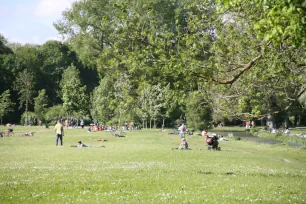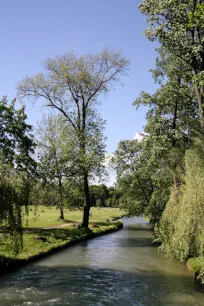Munich’s Englischer Garten (English Garden) is Europe’s largest city park. The park’s main attractions include two beer gardens, a Chinese Pagoda, a Japanese teahouse and a Greek-style temple, the Monopteros.
History


The Englischer Garten was created in the late 1700s, when Archduke and Elector Carl Theodor took it upon himself to transform the city. One of his wishes was to develop a so-called “military garden”, designed to provide soldiers with information on agriculture and also give them a place to enjoy outdoor recreation.
The military gardens opened in 1789 and soon thereafter, Carl Theodor established Munich’s first public park to the east of the gardens. The park was named Theodore’s Park and was later changed to the English Garden. It opened in 1792. Eventually, the land that included the military gardens was added to the public park.



What to See
The words English Garden refer to the style of landscaping throughout the park; that is, a rather informal garden that was a popular style in the United Kingdom in the mid-eighteenth to early nineteenth centuries. The park is larger than New York’s Central Park and is divided into two sections: the Hirschau, the northern section, is three kilometers long, and the southern portion measures two kilometers.
The southern section of the park tends to be busier, while the Hirschau is more peaceful. However, visitors do indeed flock to the two Beer Gardens located in each section of the park.
Chinesischer Turm
Built as an answer to the Great Pagoda in London’s Royal Botanical Gardens, the Chinesischer Turm is a 25-meter-high structure similar to the beautiful pagodas in the gardens of the Chinese emperors. The tower, built at the end of the eighteenth century, was bombed during World War II and rebuilt to its original design. It houses Munich’s second-largest beer garden.
More Attractions
The Kleinhesseloher Lake is also located in the English Garden. Yet another beer garden is located beside the lake.
There’s also a Japanese teahouse, built in 1972 to celebrate the Summer Olympics. Traditional Japanese tea ceremonies are held here regularly. You’ll also find the Monopteros, a small Greek-style temple in the garden, built in 1836, and an ornate children’s carousel.
Don’t be surprised if you see nude sunbathers in the Englischer Garten. The area between the Japanese tea garden and Greek temple, nicknamed the Beautiful Meadow, has been a favorite spot for sunbathing in the raw since the 1960s.

